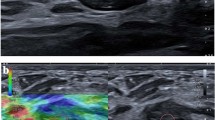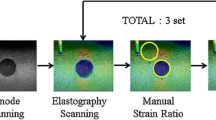Abstract
Purpose
To determine the reproducibility, accuracy, and quantitative values of the auto strain ratio system (ASRS)—a newly developed strain elastography-based program.
Materials and methods
First, the accuracy of ASRS was verified using a breast phantom. A prospective clinical study was then performed in patients. Two hundred and one women (mean age 52.4 years ± SD 14.5) with 232 breast lesions (177 benign and 55 malignant) were enrolled in this study. We assessed the correlation between ASRS and manual strain ratio (MSR), calculating the diagnostic performance to determine the cut-off. The area under the receiver operating characteristic curve (AUC) was calculated.
Results
ASRS was strongly correlated with the subtle differences in phantom stiffness (R = 0.87). In the clinical study, there was a significant correlation between MSR and ASRS with R = 0.79 (P < 0.001). ASRS (cut-off = 3.9) had a sensitivity of 81.8%, specificity of 88.7%, accuracy of 87.1%, positive predictive value of 69.2%, and negative predictive value of 94%. The AUC of ASRS was 0.89.
Conclusion
The findings from this study have demonstrated that it is possible to quantify strain elastography and control its accuracy. ASRS is expected to contribute to the standardization of breast elastography.








Similar content being viewed by others
References
Nakashima K, Shiina T, Sakurai M, et al. JSUM ultrasound elastography practice guidelines breast. J Med Ultrason. 2013;40:359–91.
Barr RG, Nakashima K, Amy D, et al. WFUMB guidelines and recommendations for clinical use of ultrasound elastography: part 2: breast. Ultrasound Med Biol. 2015;41:1148–60.
Berg WA, Cosgrove DO, Doré CJ, et al. Shear-wave elastography improves the specificity of breast US: the BE1 multinational study of 939 masses. Radiology. 2012;262:435–49.
Chang JM, Won JK, Lee KB, et al. Comparison of shear-wave and strain ultrasound elastography in the differentiation of benign and malignant breast lesions. AJR Am J Roentgenol. 2013;201:W347–56.
Itoh A, Ueno E, Tohno E, et al. Clinical application of US elastography for diagnosis. Radiology. 2006;239:341–50.
Barr RG. Real-time ultrasound elasticity of the breast: initial clinical results. Ultrasound Q. 2010;26:61–6.
Barr RG, Destounis S, Lackey LB 2nd, et al. Evaluation of breast lesions using sonographic elasticity imaging: a multicenter trial. J Ultrasound Med. 2012;31:281–7.
Farrokh A, Wojcinski S, Degenhardt F. Diagnostic value of strain ratio measurement in the differentiation of malignant and benign breast lesions. Ultraschall Med. 2011;32:400–5.
Fischer T, Peisker T, Fiedor S, et al. Significant differentiation of focal breast lesions: raw data-based calculation of strain ratio. Ultraschall Med. 2012;33:372–9.
Nakashima K, Moriya T. Comprehensive ultrasound diagnosis for intraductal spread of primary breast cancer. Breast Cancer. 2013;20:3–12.
Waki K, Kashiyama T, Suda M, et al. Development of new generation real-time tissue elastography for breast in ultrasound diagnostic scanner [published in Japanese]. MEDIX. 2016;65:32–6.
Ueno E, Tohno E, Umemoto T, et al. A preliminary prospective study to compare the diagnostic performance of assist strain ratio versus manual strain ratio. J Med Ultrason. 2015;42:521–31.
Mendelson EB, Böhm-Vélez M, Berg WA, et al. ACR BI-RADS® Ultrasound. In: ACR BI-RADS® Atlas, Breast imaging reporting and data system. Reston, VA: American College of Radiology; 2013.
Fluss R, Faraggi D, Reiser B. Estimation of the Youden Index and its associated cutoff point. Biom J. 2005;47:458–72.
Sadigh G, Carlos RC, Neal CH, et al. Accuracy of quantitative ultrasound elastography for differentiation of malignant and benign breast abnormalities: a meta-analysis. Breast Cancer Res Treat. 2012;134:923–31.
Jonathan CF, Ewertsen Caroline, Lönn Lars, et al. Strain elastography ultrasound: an overview with emphasis on breast cancer diagnosis. Diagnostics. 2013;3:117–25.
Shiina T, Nightingale KR, Palmeri ML, et al. WFUMB guidelines and recommendations for clinical use of ultrasound elastography: part 1: basic principles and terminology. Ultrasound Med Biol. 2015;41:1126–47.
Acknowledgements
We thank the following employees of Hitachi, Ltd. for contributing to the development of ASRS technology in this study: Koji Waki and Naoyuki Murayama.
Author information
Authors and Affiliations
Corresponding author
Ethics declarations
Conflict of interest
Kazutaka Nakashima has received research grants from Hitachi, Ltd. Akiko Mizutou and Sayaka Sakurai declare that they have no conflict of interest.
Funding
Funding was provided by Grants-in-aid for Scientific Research; scientific research fund (Grant no. 25461855).
Informed consent
Informed consent was obtained from all individual participants included in the study.
Ethical approval
All procedures performed in studies involving human participants were in accordance with the ethical standards of the institutional and/or national research committee and with the 1964 Helsinki declaration and its later amendments or comparable ethical standards.
About this article
Cite this article
Nakashima, K., Mizutou, A. & Sakurai, S. Auto strain ratio system for the quality control of breast strain elastography. J Med Ultrasonics 45, 261–268 (2018). https://doi.org/10.1007/s10396-017-0830-5
Received:
Accepted:
Published:
Issue Date:
DOI: https://doi.org/10.1007/s10396-017-0830-5




